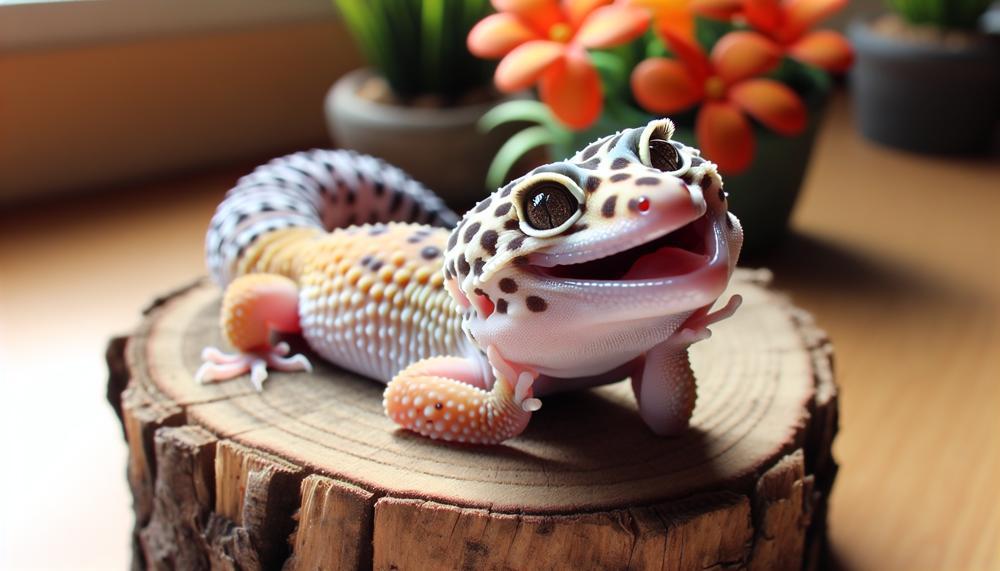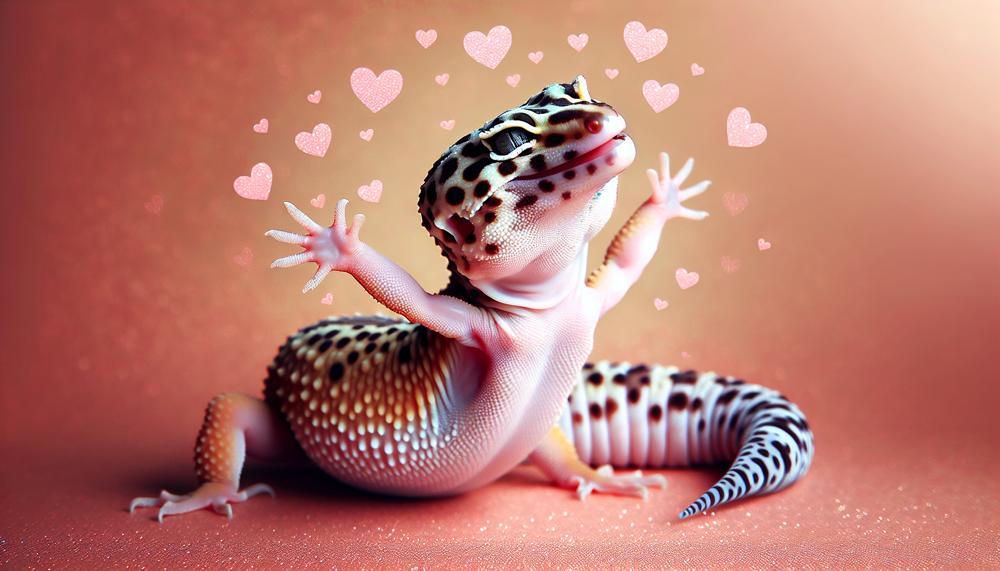Are you constantly peeking into your terrarium, searching for clues that your scaly friend is living their best life? Deciphering reptilian emotions isn’t exactly straightforward, I’m here to share the secrets of spotting a blissful leopard gecko.
These little critters can’t flash us a thumbs-up or purr like a cat, but they have their unique ways of saying, “Hey, I’m doing great.” It’s all about observing their behavior, environment, and overall health.
So, how to tell if your leopard gecko is happy the best advice?
Here are some signs that your leopard gecko might be happy:
- Active: They move around easily
- Reacts to touch: They move towards the front of their enclosure when you approach with food
- Licks tongue: They flick their tongue to taste their environment
- Enjoys relaxing: They prefer to relax in a warm spot of their enclosure
- Has wide open ears: Their ear holes are not scrunched shut, and the skin around the edges is folded
- Introverted: You can’t see them
- Extroverted: They’re excited to see you and run up to the glass to say hello
Let’s dive into the world of these fascinating creatures and ensure your leopard gecko is not just surviving, but thriving.
Contents
- 1 In Short
- 2 How to Tell if Your Leopard Gecko Is Happy
- 3 Signs of an Unhappy Leopard Gecko
- 4 How to Tell if Your Leopard Gecko Is Healthy
- 5 How to Tell if Your Leopard Gecko Is Stressed
- 6 How to Bond With Leopard Geckos
- 7 How to Make a Leopard Gecko Happy
- 8 Related Species and Articles to Leopard Geckos
- 9 Conclusion
In Short
Ensuring your leopard gecko’s happiness and contentment involves creating an environment that caters to their specific needs. Below, you’ll find a table outlining the essentials for a thriving leopard gecko:
| Housing | Secure a 20-gallon tank with a tight-fitting lid. Line with reptile carpet or paper towels and include multiple hides, climbing branches, and rocks. |
| Temperature and Lighting | Maintain a gradient with 75-85°F on the cool side and 85-95°F on the warm side using a heat mat or ceramic emitter. Use a thermostat to monitor. Provide natural sunlight or a UVB bulb for lighting. |
| Diet | Feed a variety of gut-loaded insects like crickets, mealworms, and dubia roaches. Dust with calcium and vitamin D3 supplements to prevent deficiencies. |
| Handling | Handle your gecko gently and regularly to foster trust, but never lift by the tail to avoid injury. |
| Signs of Happiness | A happy gecko is alert, active, displays a healthy appetite, sheds regularly, and may exhibit basking or exploration behaviors. |
Feeding your gecko a balanced diet and ensuring they receive the right supplements are vital steps to avert health issues. Regular handling can promote bonding and accustom your gecko to human interaction, contributing to their emotional well-being. However, always be delicate, as rough handling can cause stress or injury.
How to Tell if Your Leopard Gecko Is Happy
A content and joyful leopard gecko often exhibits several indicative behaviors and physical signs. Here’s a breakdown of what to look for:
Appearance and Health
| Signs | Details |
| Bright, clear eyes | Indicative of alertness and good health. |
| Full, fleshy tail | A storage area for fat reserves; plumpness suggests proper nutrition. |
| Healthy skin | Regular shedding and smooth skin indicate good health. |
Behavior and Temperament
| Behaviours | Details |
| Active exploration | Curiosity about their surroundings; not hiding away all the time. |
| Gentle handling response | Staying calm during interactions hints at trust and contentment. |
| Regular feeding routine | Eating well and eagerly, but not overfeeding. |
Habitat and Environment
| Habitat Needs | Details |
| Correct temperatures | A gradient from 22°C (72°F) to 32°C (90°F) allows for proper thermoregulation. |
| Humidity control | Maintained between 30-40% to replicate their natural arid environment. |
| Enrichment | Hiding spots, climbing structures, and substrates for digging contribute to a stimulating habitat. |
Observing your leopard gecko’s behavior, appetite, and physical condition will provide ample clues about its feelings towards its environment. Active and inquisitive geckos with hearty appetites, who enjoy a well-structured vivarium, are typically happy.
On the flip side, a gecko that’s often hiding, has a poor diet, or exhibits stress signs may require changes to its care or habitat.
Signs of an Unhappy Leopard Gecko
Leopard geckos, those petite and affable reptiles, exhibit certain behaviours that may flag they’re out of sorts. Here’s a looksee at some telltale signs of a gecko in the doldrums:
| Behaviour | Observation | Action to Take |
| Lethargy | Lack of movement; indifference to surroundings. | Review habitat temperature and lighting; consult a vet. |
| Jerky Motions | Sudden, erratic movements instead of smooth gliding. | Reduce stressors in the environment; provide hiding spots. |
| Poor Appetite | Refusal or disinterest in eating. | Check for illness; offer a variety of suitable foods. |
| Excessive Sleep | Sleeping more than the usual 10-12 hours a day. | Ensure a natural light cycle; seek veterinary advice. |
Addressing Unhappiness
If you spy your leopard gecko looking a bit glum, act swift to turn that frown upside down. Keep their digs shipshape with regular clean-ups and provide a balanced grub of insects. Mind the temperature and UVB lighting; these critters fancy a warm and cosy basking spot.
Leopard geckos are lone wolves by nature. If they’re cohabiting, they might be feeling hemmed in. Give them space to roam solo. On the flip side, they don’t mind a bit of gentle handling once they know you’re the one doling out the tasty morsels.
When you reckon something’s amiss, best scoot over to a vet who’s savvy with scaly critters. They’ll give your gecko the once-over and suggest ways to perk them up.
Remember, a chipper leopard gecko will be sprightly, keen on chow, and curious about their little world.
How to Tell if Your Leopard Gecko Is Healthy
Spotting the hallmarks of a healthy leopard gecko is pivotal to their care. Here’s what to look for:
Skin Condition
A hale and hearty gecko boasts smooth, vivid skin, sans bumps or lesions.
Their regular shedding should occur seamlessly, in one piece.
Weight and Tail Wellness
| Age Group | Healthy Weight Range | Tail Appearance |
| Juveniles | Less than 45 grams | Proportionate, but growing |
| Adults | 45-80 grams | Plump, reserve of fat |
Appetite and Digestion
A sprightly gecko will chow down regularly. Their droppings should be solid and consistent in colour.
Watch out for any changes in their stool which could signal digestive strife.
Bright Eyes
Peepers should be crystal clear, bright, and fully open. Cloudy or sunken eyes can hint at health snags.
Liveliness and Limberness
Expect an energetic gecko, curious and nimble in its habitat. They ought to climb and jump with ease, showcasing a robust grip.
Should you spot any deviations from these norms, it’s sage to consult a vet who’s wise to reptile health. Remember, these creatures rely on you to catch the early whispers of any issues.
How to Tell if Your Leopard Gecko Is Stressed
To discern if your leopard gecko is under duress, keen observation of its behaviour and physical condition is key. The following table encapsulates common stress indicators:
| Behavioural Signs | Physical Signs | Environmental Signs |
| Refusing food | Irregular defecation | Extended hide dwelling |
| Jittery or defensive conduct | Tail thinning | Excessive glass climbing |
| Tail twitching or wagging | Noticeable weight loss | Persistent digging |
Decoding the Signs
- Appetite Loss: A gecko shunning its meals might be signaling unease.
- Skittish or Aggressive Reactions: If your gecko scrambles away or becomes hostile when approached, it could be a sign of distress.
- Hiding Habitually: Geckos relish solitude, but excessive hiding could point to stress.
- Tail Movement: A twitching or wagging tail can be a gecko’s way of expressing agitation.
- Bowel Irregularities: Stress can throw off their digestive rhythm, leading to infrequent bowel movements.
- Glass Surfing: Persistent attempts to climb the enclosure’s walls may indicate discomfort with their surroundings.
- Digging: Excessive digging, especially outside of normal burrowing behaviour, may be a sign of stress.
Addressing your gecko’s stress involves tweaking their habitat to suit their preferences, ensuring a tranquil handling routine, and keeping a close eye for any health concerns. If signs persist, consult a vet familiar with reptiles to rule out underlying health issues.
How to Bond With Leopard Geckos
Bonding with your leopard gecko and ensuring its joy is a matter of gentle perseverance and understanding of their world.
Understanding Your Gecko’s Needs
| Age and Size | Handle geckos older than 4 months and longer than 5-6 inches to ensure safety. |
| Environment | Provide a stress-free habitat with suitable hiding spots and temperature gradients. |
| Temperament | Respect their individual personality, some may take longer to trust. |
Creating a Calm Atmosphere
- Keep the vibe around the enclosure serene, avoiding sudden movements and loud din.
Timing Your Interactions
- Engage with your gecko during twilight hours, their natural time to stir and hunt.
Feeding as Bonding Time
- Try hand-feeding treats to associate your presence with something gratifying.
Handling with Care
- When you handle your gecko, be tender, never picking them up by the tail.
Reading Gecko Cues
- Look out for signs of distress such as heavy breathing or attempting to flee. If noticed, give them space.
Remember, each gecko is a distinct individual. While one may warm up to you swiftly, another might need a lengthier span to build trust. Keep interactions short and sweet at the start, gradually increasing time as your gecko gets more relaxed with your presence.
How to Make a Leopard Gecko Happy
Ensuring your leopard gecko’s happiness and well-being involves creating an environment that caters to their natural behaviors and needs. Here are key strategies:
Habitat Set-up
Design a vivarium that mimics their natural habitat, complete with hiding spots, a thermal gradient, and suitable substrate for burrowing.
| Feature | Description | Importance |
| Hiding Spots | Provide multiple hideaways to simulate the security of rocks and burrows. | Essential for stress reduction and comfort. |
| Thermal Gradient | Arrange the enclosure with a warm side (30-32°C) and a cool side (24-26°C). | Allows thermoregulation for health and digestion. |
| Substrate | Use paper towels, reptile carpet, or fine sand for juveniles/adults. | Enables natural burrowing behavior and reduces impaction risks. |
Diet and Nutrition
Offer a variety of live insects, gut-loaded and dusted with vitamin and mineral supplements, to mimic their insectivorous feeding habits in the wild.
Handling and Interaction
Gentle and regular handling can build trust, but always respect your gecko’s boundaries and avoid over-handling to prevent stress.
Enrichment
Implement environmental enrichment such as rocks for climbing, live plants, and occasional safe objects to explore to keep them mentally stimulated.
Monitoring Health
Watch for signs of a content gecko, like a good appetite and active exploration. If they seem lethargic or lose their appetite, a vet checkup may be in order.
Regular Maintenance
Keep their home spotless, with a weekly clean-up and immediate removal of uneaten food or waste, as a clean environment is pivotal for their health.
Remember, these cold-blooded critters need you to be warm-hearted in their care. Keep an eagle eye on their behavior and body language – it’ll tell you volumes about their state of bliss. Give them space to skedaddle and places to hide, and you’ll have a chuffed gecko on your hands.
Related Species and Articles to Leopard Geckos
Caring for a leopard gecko involves a blend of understanding their habitat needs, diet, behaviour, and health requirements.
When comparing the care of leopard geckos to that of related species, such as African fat-tailed geckos or banded geckos, there are subtle but important differences to keep in mind.

Habitat Setup
Leopard geckos hail from arid regions, so they require a warm, dry environment with a thermal gradient to regulate their body temperature. Related species may have similar requirements, but the precise temperature range can differ.
| Species | Temperature (Day) | Temperature (Night) |
| Leopard Gecko | 29-32°C | 20-24°C |
| African Fat-tailed Gecko | 26-29°C | 22-24°C |
| Banded Gecko | 27-30°C | 18-22°C |
Diet
Leopard geckos are insectivores, thriving on a diet of live insects like crickets, mealworms, and dubia roaches.
Nutritional needs can be species-specific, but generally, gut-loading and dusting insects with vitamins and minerals is crucial.
Behaviour
Understanding each species’ behaviour is essential for proper care. Leopard geckos are generally docile and can be handled regularly, whereas some related species might be more skittish or nocturnal, affecting interaction.
Health Monitoring
Regular health checks are vital for spotting the early signs of common ailments like metabolic bone disease or respiratory infections. While these issues can affect many gecko species, the exact symptoms and treatments may vary.
Environmental Enrichment
All geckos benefit from environmental enrichment, but preferences can vary. Providing hides, climbing structures, and substrate for digging can support natural behaviours, but the layout should suit the specific species.
Remember, leopard geckos have distinct personalities and may display unique preferences, so observe and adapt their care as needed. For a deep dive into their fascinating world, consult credible sources like Wikipedia’s Leopard Gecko.
Conclusion
In summary, making sure your leopard gecko is happy requires careful observation of their behavior, creating an environment that suits them, and taking care of their nutrition and general health.
A contented leopard gecko will have bright eyes, a plump tail, and frequent shedding of skin. They will enthusiastically devour a variety of gut-loaded insects, explore their home aggressively, and react calmly to mild touch. They will also follow a regular feeding schedule.
Lethargy, jerky movements, low eating, or excessive sleeping are all indications of stress or unhappiness. It’s time to evaluate your gecko’s living circumstances and speak with a veterinarian who specializes in reptile care. Recall that a contented gecko is one that is aware of its surroundings, energetic, and inquisitive. It also has a healthy appetite and enjoys exploring its well organized vivarium.
It is essential to create a cozy environment with the ideal humidity, temperature gradient, and enrichment. Treat your gecko gently, provide a well-balanced meal along with any required vitamins, and keep an eye out for any telltale indications of happiness or discomfort.






